Secunderabad
Secunderabad /sɪkəndərˈɑːbɑːd/ ([sikŋdɾaːbaːd] (![]()
Secunderabad Lashkar,
Ulwul | |
|---|---|
 Secunderabad Clock Tower | |
| Nickname(s): Sec'bad | |
 Secunderabad Location in Telangana, India  Secunderabad Secunderabad (India) | |
| Coordinates: 17.45°N 78.5°E | |
| Country | India |
| State | Telangana |
| District | Hyderabad District |
| Metro | Hyderabad Metropolitan Region |
| Establishment | 1806 |
| Founded by | Sikandar Jah |
| Named for | Sikandar Jah |
| Government | |
| • Body | Greater Hyderabad Municipal Corporation Secunderabad Cantonment Board[1] |
| • MP | G. Kishan Reddy |
| • MLA | Padma Rao Goud |
| Area | |
| • Total | 64.5 km2 (24.9 sq mi) |
| Elevation | 543 m (1,781 ft) |
| Population (2011) | |
| • Total | 213,698 |
| • Density | 3,300/km2 (8,600/sq mi) |
| Languages | |
| • Official | |
| Time zone | UTC+5:30 (IST) |
| Pincode(s) | 500 xxx |
| Telephone code | 040 |
| Vehicle registration | TS-10[2] |
| Website | ghmc |
Geographically divided from Hyderabad by the Hussain Sagar lake, Secunderabad is no longer a separate municipal unit and has become part of Hyderabad's Greater Hyderabad Municipal Corporation (GHMC). Both cities are collectively known as Hyderabad and together form the fifth-largest metropolis in India. Being one of the largest cantonments in India, Secunderabad has a large presence of army and air force personnel.[4][5]
History
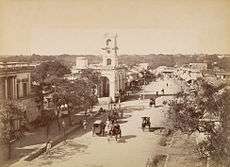
Following the dissolution of the Chalukya empire into four parts in the 11th century, the areas around the present day Hyderabad and Secunderabad came under the control of the Kakatiya dynasty (1158–1310), whose seat of power was at Warangal, 148 km (92 mi) northeast of modern Hyderabad.[7]
Secunderabad is also the site where the then Mughal emperor Ahmad Shah Bahadur was defeated in the year 1754 by the Maratha Confederacy; the emperor arrived after the death of Nawab Anwaruddin Khan nearby at the Battle of Ambur in 1749.
The area around Secunderbad changed hands between various rulers, and the area was part of Nizam's Hyderabad by the 18th century.[8][9]

Modern Secunderabad was founded as a British cantonment after Nizam Asaf Jah II was defeated by the British East India Company. He was then forced to sign the 1798 Treaty of Subsidiary Alliance[10][11] to get the favor of British troops camped in the village of Ulwul, north-east of Hussain Sagar, the lake that separates Secunderabad from its twin city Hyderabad. In 1803, Nizam Sikandar Jah, the third Nizam of Hyderabad, changed Ulwul's name to Secunderabad after himself.[10] The city was formed in 1806, after the order was signed by the Nizam allotting the land north of Hussain Sagar to set up the British Cantonment.[12]
The twin cities are separated by the man-made Hussain Sagar lake, which was built during the reign of the Qutb Shahi dynasty in the 16th century. Unlike Hyderabad, the official language of Secunderabad was English.[13] Secunderabad was exempted from customs duty on imported goods, thus making trade very profitable. Various new markets such as Regimental Bazaar and General Bazaar were created. After the First War of Indian Independence of 1857, the construction of a 7-metre-high (23 ft) wall was started at Trimulgherry and completed in 1867.[13]
Secunderabad Junction railway station, one of the largest in India and the zonal headquarters of South Central Railway, was established in 1874. The King Edward Memorial Hospital, now known as Gandhi Hospital, was established in 1851. A civil jail (now a heritage building known as Old Jail complex near Monda Market) was also established.[14] Originally constructed in 1860 as the country house of the British Resident at Hyderabad, the Residency House is now known as the Rashtrapati Nilayam, the official retreat of the President of India.[15]
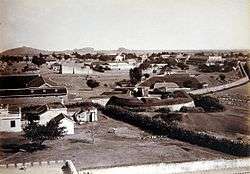
Sir Winston Churchill, the prime minister of the United Kingdom during World War II, was posted in Secunderabad during the 1890s as a subaltern in the British Army.[16] Sir Ronald Ross conducted his initial research on the cause of malaria in the city of Secunderabad.[17] The original building is today called the Sir Ronald Ross Institute and is located on Minister Road.
Secunderabad Municipality was first formed in 1945. Later in 1950, along with Hyderabad Municipality, it was upgraded to Secunderabad Municipal Corporation under the Hyderabad Corporation Act, 1950. In 1960, by the Hyderabad Municipal Corporation Act of 1955, Secunderabad Municipal Corporation was merged with Hyderabad Corporation to form a single municipal corporation.[18] Today Secunderabad is part of the Hyderabad district.
Post-Independence, the Secunderabad Cantonment Board came under the jurisdiction of the Indian Armed forces. Consequently, large military units were established. The popular neighbourhoods in Secunderabad are Paradise Circle, Trimulgherry, Jawaharnagar colony, Marredpally, Jeera, General Bazar, Sitaphalmandi, Kharkhana, Ranigunj, and New Bhoiguda. Begumpet Airport is close to Secunderabad and served the twin city until early 2008.
Geography
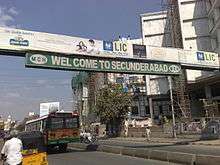
Situated in the North of Hyderabad at 17.45°N 78.5°E.,[19] Secunderabad lies on the northern part of the Deccan Plateau.[18][20] Secunderabad has an average elevation of 543 metres (1781 ft). Most of the area has a rocky terrain and some areas are hilly.
Secunderabad is 1,566 kilometres (973 mi) south of Delhi, 699 kilometres (434 mi) southeast of Mumbai, and 570 kilometres (350 mi) north of Bangalore by road.[21] It is connected to Hyderabad by Rastrapathi Road (formerly known as King's Way) and MG Road (formerly known as James' Street) via Tank Bund. As a constituent of Greater Hyderabad, Secunderabad is one of the largest metropolitan areas in India. Lot of residential areas are located nearby like West Marredpally, East Marredpally, Kharkhana, Bowenpally as it is calm and serene.
Climate
Secunderabad has a tropical savanna climate (Köppen: Aw), with hot summers from late February to early June, the monsoon season from late June to early October, and a pleasant winter from late October to early February. In the evenings and mornings, the climate is relatively cool. Most of the rainfall is concentrated in the monsoon months from June to September.
Winter lasts for only about 2 1⁄2 months, during which the lowest temperature occasionally dips to 10 °C (50 °F) in December and January.[22] May is the hottest month, with average daily lows of 26 °C (79 °F) and highs of 38.8 °C (102 °F). January is the coldest month with average lows of 14.7 °C (58 °F) and highs of 28.6 °C (83 °F).[23]
| Climate data for Secunderabad India (1951–1980) | |||||||||||||
|---|---|---|---|---|---|---|---|---|---|---|---|---|---|
| Month | Jan | Feb | Mar | Apr | May | Jun | Jul | Aug | Sep | Oct | Nov | Dec | Year |
| Average high °C (°F) | 28.6 (83.5) |
31.8 (89.2) |
35.2 (95.4) |
37.6 (99.7) |
38.8 (101.8) |
34.4 (93.9) |
30.5 (86.9) |
29.6 (85.3) |
30.1 (86.2) |
30.4 (86.7) |
28.8 (83.8) |
27.8 (82.0) |
32.0 (89.6) |
| Average low °C (°F) | 14.7 (58.5) |
17.0 (62.6) |
20.3 (68.5) |
24.1 (75.4) |
26.0 (78.8) |
23.9 (75.0) |
22.5 (72.5) |
22.0 (71.6) |
21.7 (71.1) |
20.0 (68.0) |
16.4 (61.5) |
14.1 (57.4) |
20.2 (68.4) |
| Average precipitation mm (inches) | 3.2 (0.13) |
5.2 (0.20) |
12.0 (0.47) |
21.0 (0.83) |
37.3 (1.47) |
96.1 (3.78) |
163.9 (6.45) |
171.1 (6.74) |
185.5 (7.30) |
90.9 (3.58) |
16.2 (0.64) |
6.1 (0.24) |
812.5 (31.99) |
| Source: [24] | |||||||||||||
Demographics
Secunderabad had a population of 204,182. Males constituted 51% of the population and females 49%. Secunderabad had an average literacy rate of 73%, higher than the national average of 59.5%; male literacy was 78%, and female literacy was 68%. 11% of the population was under 6 years of age. The city has a sizable population of Anglo-Indians, who mainly resided in the South Lallaguda area of Secunderabad which was popularly known as Little England.[25] Many Anglo-Indians have emigrated to other countries in the English-speaking world over the last few decades.[26]
Culture
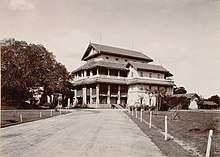
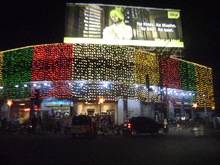
Due to the presence of communities such as Parsis and Anglo-Indians alongside British and native inhabitants, Secunderabad was historically a cosmopolitan city.[13][28] Secunderabad used to be referred to by the locals as Lashkar, meaning the army and the city's culture reflected the same. Secunderabad was a liberal city compared to Hyderabad due to the presence of the British. Plaza cinema was the only theatre in India where viewers could sip a beer while watching a movie. Sangeet was a popular cinema theatre that screened only Western movies.[29]
The popular Secunderabad Club was established in 1878, at a country house gifted by Salar Jung I. Secunderabad has a more laid-back atmosphere because it is mainly a residential area with fewer government offices and corporate establishments.
Many outdoor events such as the Republic Day parade and fairs are held in the Gymkhana or Parade grounds.[30] Christmas is celebrated by the Christian residents. An annual festival known as the Bonalu is celebrated by the Hindus of the Telangana state. It is usually held during the Ashadha, which is at the start of the monsoon season.[31] Ramadan, the Islamic holy month of fasting, is observed by the local Muslims. There are old temples like Laxminarayana Swami Temple and Mahakali Temple. Local churches like Wesely church and St. Mary's church add to cosmopolitan culture of the city. The culture of Secunderabad is distinctly different from that of Hyderabad's Nawabi culture.[26][28][32]
Economy
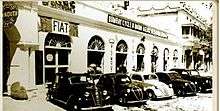
ITC, Infosys, Intergraph, and Coromandel International are some of the major private companies which have their offices in Secunderabad. Being the headquarters of South Central Railway, Secunderabad is a major centre for railway activity. Industrial areas such as Bolarum, Moula-Ali, Nacharam, Ghatkesar, Uppal , etc. are in Secunderabad. Secunderabad Cantonment Board houses a large number of defence units. Units of the Department of Atomic Energy (DAE), such as Atomic Minerals Directorate for Exploration and Research (AMD), Nuclear Fuel Complex (NFC), and ECIL are close to Secunderabad.[33]
Government
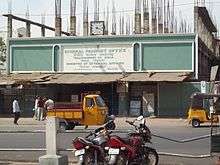
The Greater Hyderabad Municipal Corporation (GHMC), established in 2007, is responsible for the administration and infrastructure of Secunderabad. Secunderabad Municipality was first formed in 1945. Later in 1950, along with Hyderabad Municipality, it was upgraded to Secunderabad Municipal Corporation under the Hyderabad Corporation Act of 1950. In 1960, by the Hyderabad Municipal Corporation Act of 1955, Secunderabad Municipal Corporation was merged with Hyderabad Corporation to form a single Municipal Corporation.[18] During Nizam's period, Secunderabad Cantonment was under the control of the British Raj. Today those areas, and most parts of Secunderabad where defence installations are located, is under the purview of Secunderabad Cantonment Board. There are eight civilian wards in Secunderbad Cantonment Board, with a population of four lakh.[34]
Secunderabad Municipality office which was located on Sardar Patel Road is to be demolished for the metro rail project. The new office is located at West Marredpally.[35]
Secunderabad forms a part of Secunderabad Lok Sabha constituency and is represented with seven legislative assembly seats. The present Member of Parliament is G. Kishan Reddy,[36][37][38] who is also a Minister of State in the Union Cabinet.[39][40] The incumbent Member of Legislative Assembly is a candidate from Telangana Rasthra Samiti (TRS), who is also a Minister under the Telangana government.[41]
Media
Major English dailies Deccan Chronicle and Financial Chronicle and the Telugu daily Andhra Bhoomi are published from Secunderabad. FM radio Radio Mirchi is located at SP Road in Secunderabad.
Sports
The most-popular sport played in Secunderabad is cricket.[42] During pre-independence era Secunderabad had various sports facilities built for serving Englishmen.[43][44] Presently, no major stadiums are located in Secunderabad. However some open grounds belonging to railways and military establishments are used for various sporting activities. These are Gymkhana Ground, Parade Ground, Polo Ground, Bollarum Golf Course, and Railway Golf Course. The erstwhile Indian Premiere League cricket franchise, Deccan Chargers was based in Secunderabad.
Various state sports associations such as Amateur Boxing Association, Basketball Association, Women's Cricket Association, Sculling and Rowing Association, and Hyderabad Hockey Association are located in Secunderabad[45]
Transport
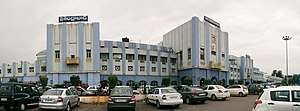
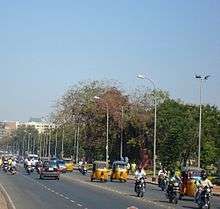
The most commonly used forms of medium-distance transport in Secunderabad include government-owned services such as light railways and Telangana State Road Transport Corporation (TSRTC) buses,[46] as well as privately operated auto rickshaws.[47] It is connected by Secunderabad East metro station of Hyderabad Metro.
The city is the headquarters of the South Central Railway Zone of the Indian Railways. It is served by Secunderabad Railway Station, one of the oldest and largest railway stations in the twin cities. Secunderabad is also a major railway junction in the Wadi–Vijayawada railway route.
Secunderabad is the hub for the city bus transport run by the TSRTC, and is connected to major destinations of both Hyderabad and Secunderabad. Major bus stations are the Jubilee Bus Station and the Rathifile Bus station.
The Tank Bund road is connects Hyderabad and Secunderabad. Abutting the Hussain Sagar lake, the Tank Bund road is an arterial road and the main thoroughfare connecting Secunderabad with Hyderabad. Maximum speed limits within the city are 50 km/h (31 mph) for two-wheelers and cars, 35 km/h (22 mph) for auto rickshaws and 40 km/h (25 mph) for light commercial vehicles and buses.[48]
The nearest airport is Rajiv Gandhi International Airport in Hyderabad, Begumpet Airport having closed in 2008.
Education
Schools in Secunderabad, similar to other schools in Hyderabad and other parts of Telangana follow a 10+2+3 plan. Schools are a mix of publicly and privately run institutions, with two-thirds of students in private schools.[49] Languages of instruction include English, Hindi, Urdu,[50] and Telugu. Depending on the institution students are studying in, they are required to sit in the Secondary School Certificate[51] or the Indian Certificate of Secondary Education. After completing secondary education, students enroll in schools or junior colleges with a higher secondary facility. Due to the prolonged presence of the British, Secunderabad has convent schools established by Christian missionaries.
Research institutes such as National Institute of Nutrition, Center for Cellular and Molecular Biology, Indian Institute of Chemical Technology, The English and Foreign Languages University, Osmania University, Hamstech College of Creative Education and National Geophysical Research Institute are in Tarnaka, which is close to Secunderabad.
Notable people
- Gummadi Vittal Rao, Poet Writer, revolutionary Telugu balladeer and local activist from pre-independence.
- Dasaradhi Rangacharya, Telugu Writer, Sahitya Akademi Award winner.
- Sunil Chhetri, Indian footballer
- Shyam Benegal, film director and screenwriter
- M. L. Jaisimha, test cricketer and TV commentator[52]
- Diana Hayden, 1997 Femina Miss India and 1997 Miss World winner
- Padmapriya Janakiraman, film actress and model
- Tanikella Bharani, actor, writer and film director
- K. N. T. Sastry, writer and film director, film critic and journalist
- James Yates, English cricketer
- Tharun Bhascker, actor, writer and film director
References
- "Secunderabad Cantonment Board".
- "District Codes". Government of Telangana Transport Department. Archived from the original on 7 January 2016. Retrieved 4 September 2014.
- "Hyderabad-Secunderabad India – History -hyderabad-secunderabad.com". Archived from the original on 24 February 2008. Retrieved 13 March 2008.
- it has one of the largest railway station which serves for both the cities as Hyderabad does not have any railway stationIndiastudychannel.com
- "SCB.aponline.gov.in". Archived from the original on 13 September 2010. Retrieved 2 September 2010.
- Kolluru, Suryanarayana (1993). Inscriptions of the minor Chalukya dynasties of Andhra Pradesh. Mittal Publications. p. 1. ISBN 81-7099-216-8.
- Sardar, Marika (2007). Golconda through time: a mirror of the evolving Deccan. pp. 19–41. ISBN 978-0-549-10119-2.
- Jaisi, Sidq (2004). The nocturnal court: life of a prince of Hyderabad. Oxford University Press. pp. 29–30. ISBN 978-0-19-566605-2.
- Sastri, Kallidaikurichi Aiyah Nilakanta (1976). A history of south India from prehistoric times to the fall of Vijayanagar. Oxford University Press. p. 192. ISBN 0-19-560686-8.
- Ikram, S.M. (1964). "A century of political decline: 1707–1803". In Embree, Ainslie T (ed.). Muslim civilization in India. Columbia University. ISBN 978-0-231-02580-5. Retrieved 7 October 2011.
- Richards, J. F. (1975). "The Hyderabad Karnatik, 1687–1707". Modern Asian Studies. Cambridge University Press. 9 (2): 241–260. doi:10.1017/S0026749X00004996.
- Shyamola Khanna. "Harmony Org". Harmonyindia.org. Archived from the original on 17 June 2012. Retrieved 3 August 2012.
- "Hyderabad History". GHMC. Retrieved 30 July 2010.
- "200-year celebrations begin in Secunderabad" (PDF). India eNews. Archived from the original on 28 April 2011. Retrieved 30 July 2010.CS1 maint: unfit url (link)
- "Bridging two cultures". Narendra Luther. Archived from the original on 24 November 2010. Retrieved 1 August 2010.
- "64th Meeting Minutes". Hyderabad Urban Development Authority. 27 May 2006. Archived from the original on 21 July 2011. Retrieved 2 August 2010.
- Mohit Joshi (27 December 2008). "President Patil arriving Hyderabad on 15-day southern sojourn". TopNews. Retrieved 3 August 2012.
- Globalsecurity.org
- "The Hindu dt. 13th May 2010". Chennai, India: Te Hindu. 13 May 2010. Retrieved 1 August 2010.
- "Greater Hyderabad Municipal Corporation". Greater Hyderabad Municipal Corporation (GHMC). Archived from the original on 1 January 2016. Retrieved 17 August 2011.
- Falling Rain Genomics, Inc – Secunderabad
- "Physical Feature" (PDF). AP Government. 2002. Archived from the original (PDF) on 16 April 2012. Retrieved 4 April 2012.
- Google (6 January 2013). "Secunderabad" (Map). Google Maps. Google. Retrieved 6 January 2013.
- "Weatherbase entry for Hyderabad". Canty and Associates LLC. Archived from the original on 30 October 2013. Retrieved 13 June 2012.
- "Hyderabad". India Meteorological Department. Archived from the original on 10 November 2013. Retrieved 13 June 2012.
- "Hyderabad". July 2011. Archived from the original on 30 April 2010. Retrieved 30 May 2010.
- "Pedal power". The Hindu. Chennai, India. 18 November 2003.
- Venkateshwarlu, K. (8 March 2011). "A captivating tale of a twin city". The Hindu. Chennai, India.
- "Irani Chai Hona?". The Times of India. 3 July 2011. Retrieved 3 July 2011.
- "HyderabadSecunderabad India – History". hyderabad-secunderabad.com. Archived from the original on 24 February 2008. Retrieved 3 August 2012.
- "Sangeet theatre to fade into oblivion". The Hindu. Chennai, India. 18 August 2007. Retrieved 17 January 2012.
- Kenneth Pletcher, ed. (15 August 2010), The Geography of India: Sacred and Historic Places, Britannica Educational Publishing, p. 190, ISBN 978-1-61530-202-4
- "Lashkar Bonalu kicks off at Ujjaini temple tomorrow". The Times of India. 16 July 2011.
- "Press release (PR) distribution / newswire service from India PRwire" (PDF). Indiaenews.com. Archived (PDF) from the original on 28 April 2011. Retrieved 8 July 2013.
- Andhrapradeshstate.in
- "Secunderabad Cantonment Board met just twice this year to discuss people issues".
- "GHMC Sec'bad office to make way for metro rail". The Times of India. 9 November 2011. Retrieved 17 January 2012.
- Richi, Priyanka (29 May 2019). "'Bring notebooks, not bouquets' : BJP Secunderabad MP elect's unique appeal". www.thenewsminute.com. Retrieved 5 September 2019.
- P, Pavan (29 May 2019). "Secunderabad BJP MP-elect G Kishan Reddy tells people to bring notebooks instead of bouquets and shawls". Mumbai Mirror. Archived from the original on 12 June 2019. Retrieved 5 September 2019.
- "Secunderabad Election Results 2019 Live Updates: G. Kishan Reddy of BJP Wins". News18. Retrieved 5 September 2019.
- Somasekhar, M (31 May 2019). "The sole Minister from Telugu States". The Hindu Businessline. Retrieved 5 September 2019.
- "Telangana's first-time MP to find place in Modi ministry". Business Standard India. 30 May 2019. Archived from the original on 30 May 2019. Retrieved 5 September 2019.
- "Telangana Assembly. Members information". 2 June 2014. Retrieved 9 November 2014.
- Kapadia, Novy (2001). "Triumphs and disaster: the story of Indian football, 1889–2000" (PDF). Soccer and Society. 2 (2): 19. doi:10.1080/714004851. Archived (PDF) from the original on 13 August 2012. Retrieved 3 April 2012.
- Warwick, Nigel (2007). Constant Vigilance: The RAF Regiment in the Burma Campaign. Casemate Publishers. p. 10. ISBN 9781844155002. Retrieved 23 September 2014.
- Vottery, Madhu (2010). A Guide to the Heritage of Hyderabad: The Natural and the Built. Rupa Publications. ISBN 9788129116567. Retrieved 23 September 2014.
- "LIST OF ANDHRA PRADESH STATE ASSOCIATIONS WITH SECRETARY & PRESIDENTS". Archived from the original on 21 September 2014. Retrieved 23 September 2014.CS1 maint: unfit url (link)
- Didyala, Amrita (16 May 2012). "AC buses are RTC's white elephants". Asian Age. Archived from the original on 11 November 2013. Retrieved 20 May 2012.
- "Executive summary of detailed project report" (PDF). Government of Andhra Pradesh. Archived from the original (PDF) on 5 January 2012. Retrieved 18 May 2012.
- "Speed limits fixed for vehicles on city roads". The Hindu. 10 January 2010. Archived from the original on 18 September 2011. Retrieved 25 May 2012.
- Bajaj, Vikas; Yardley, Jim (30 December 2011). "Many of India's poor turn to private schools". The New York Times. Archived from the original on 1 April 2012. Retrieved 10 June 2012.
- "Centre extends 40-cr aid to Urdu schools". The Times of India. 27 February 2002. Archived from the original on 11 September 2015. Retrieved 9 July 2011.
- "SSC results: girls score higher percentage". The Hindu. 22 May 2011. Archived from the original on 10 November 2013. Retrieved 9 September 2011.
- "Top sporting icons from Hyderabad". Deccan Chronicle. 29 July 2013. Archived from the original on 20 February 2014. Retrieved 1 August 2013.
External links
| Wikimedia Commons has media related to Secunderabad. |
- Secunderabad Community, Secunderabad Community Website
- Hyderabad-india.net, Hyderabad info
- hyderabad.org.uk, history of Secunderabad